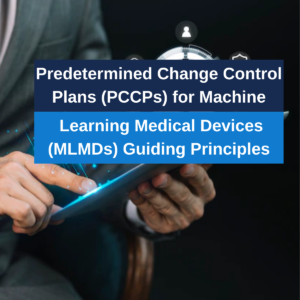Predetermined Change Control Plans (PCCPs) for Machine Learning Medical Devices (MLMDs) Guiding Principles
Artificial intelligence (AI) and machine learning (ML) are rapidly transforming healthcare. MLMDs are medical devices that use AI and ML to enhance their performance and capabilities. However, the unique characteristics of MLMDs, such as their ability to learn and adapt over time, pose new challenges for regulatory oversight and change management.
What are Predetermined Change Control Plans (PCCPs)?
PCCPs are a new approach to change management for Machine Learning Medical Device (MLMD). They are plans that are developed and submitted to regulators before changes to an MLMD are implemented. PCCPs describe the specific changes that the manufacturer intends to make, the protocol for implementing and controlling those changes, and the assessment of the impact of the changes.

principles for Predetermined Change Control Plans (PCCPs)
In 2002, the US Food and Drug Administration (FDA), Health Canada and the UK Medicines and Healthcare products Regulatory Agency (MHRA) jointly identified five guiding principles for PCCPs:
- Focused and limited: PCCPs should describe specific changes to an MLMD that are limited to changes within the intended use or purpose of the original MLMD.
- Risk-based: PCCPs should be driven by a risk-based approach that follows the principles of risk management. This means that the PCCP should identify and assess the risks associated with the proposed changes and implement appropriate mitigation strategies.
- Evidence-based: The PCCP should be supported by evidence that demonstrates the safety and effectiveness of the MLMD with the planned changes.
- Transparent: PCCPs should be transparent to users and other stakeholders. This means providing clear and detailed information about the planned changes, the benefits and risks of the changes, and the monitoring and mitigation strategies that will be in place.
- Total Product Lifecycle (TPLC) perspective: PCCPs should be developed and implemented from a TPLC perspective. This means considering the perspectives of all stakeholders and risk management practices throughout the TPLC.
Benefits of PCCPs
PCCPs can provide a number of benefits, including
- Alignment of regulatory processes with the rapid pace of change in MLMDs: PCCPs can help ensure that regulatory processes are aligned with the rapid and continuous approach to change management in MLMDs.
- Risk management: PCCPs can help to manage risk in a timely and ongoing manner through monitoring, maintenance and/or improvement of device performance.
- High regulatory standards: PCCPs can help maintain high regulatory standards to ensure the safety and efficacy of devices.
Conclusion
PCCPs are a new and promising approach to change management for MLMDs. The guiding principles outlined in this blog post can help manufacturers develop and implement robust PCCPs that support the safety and effectiveness of MLMDs.

